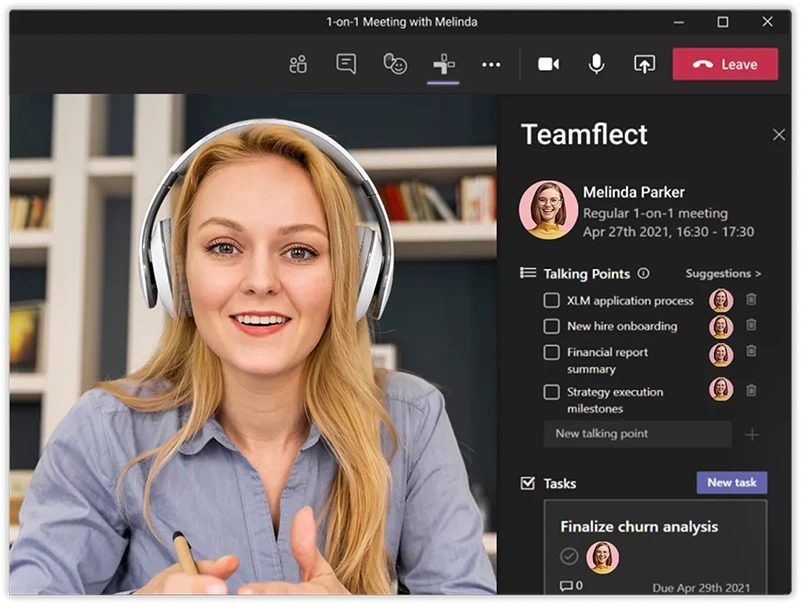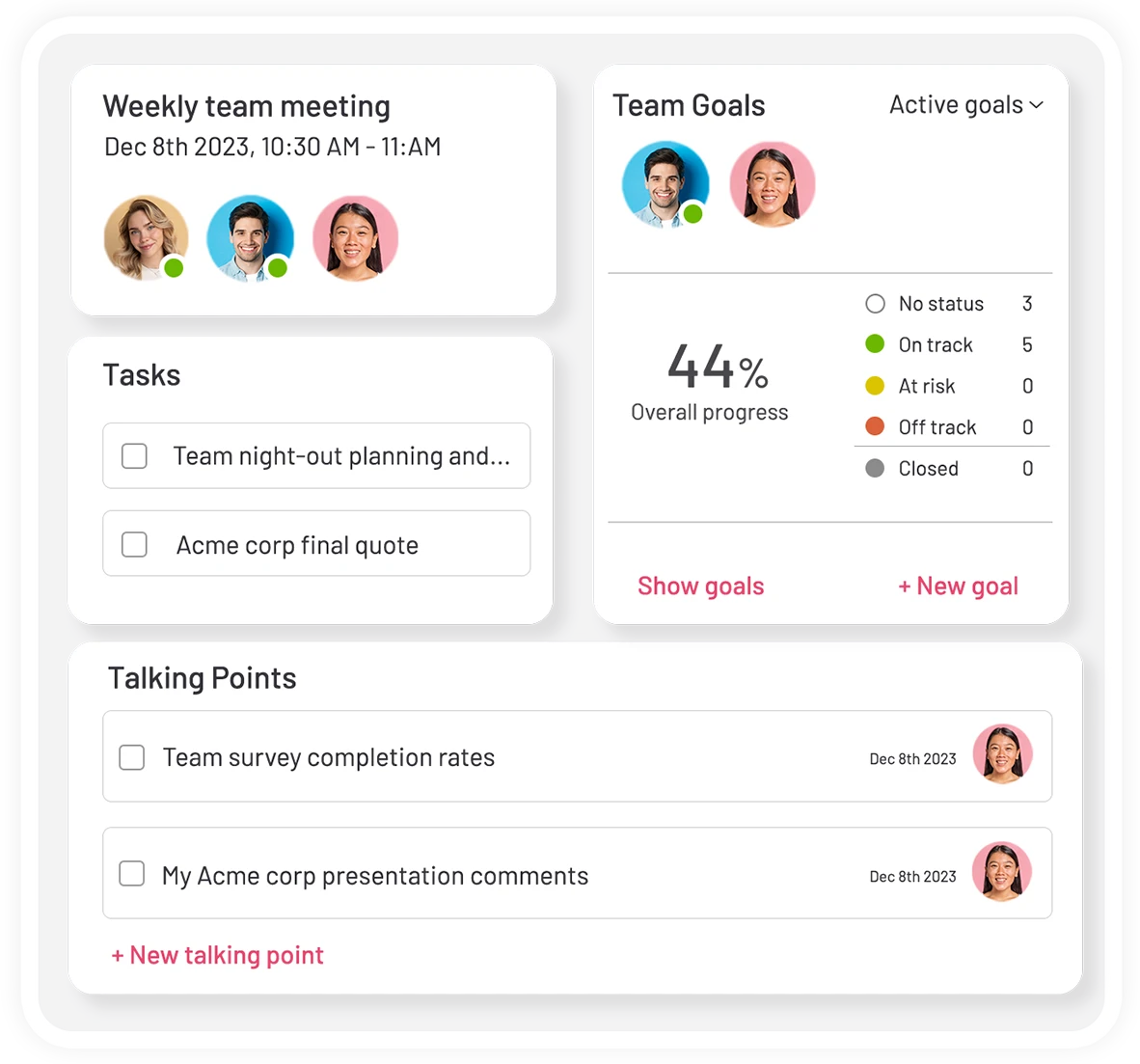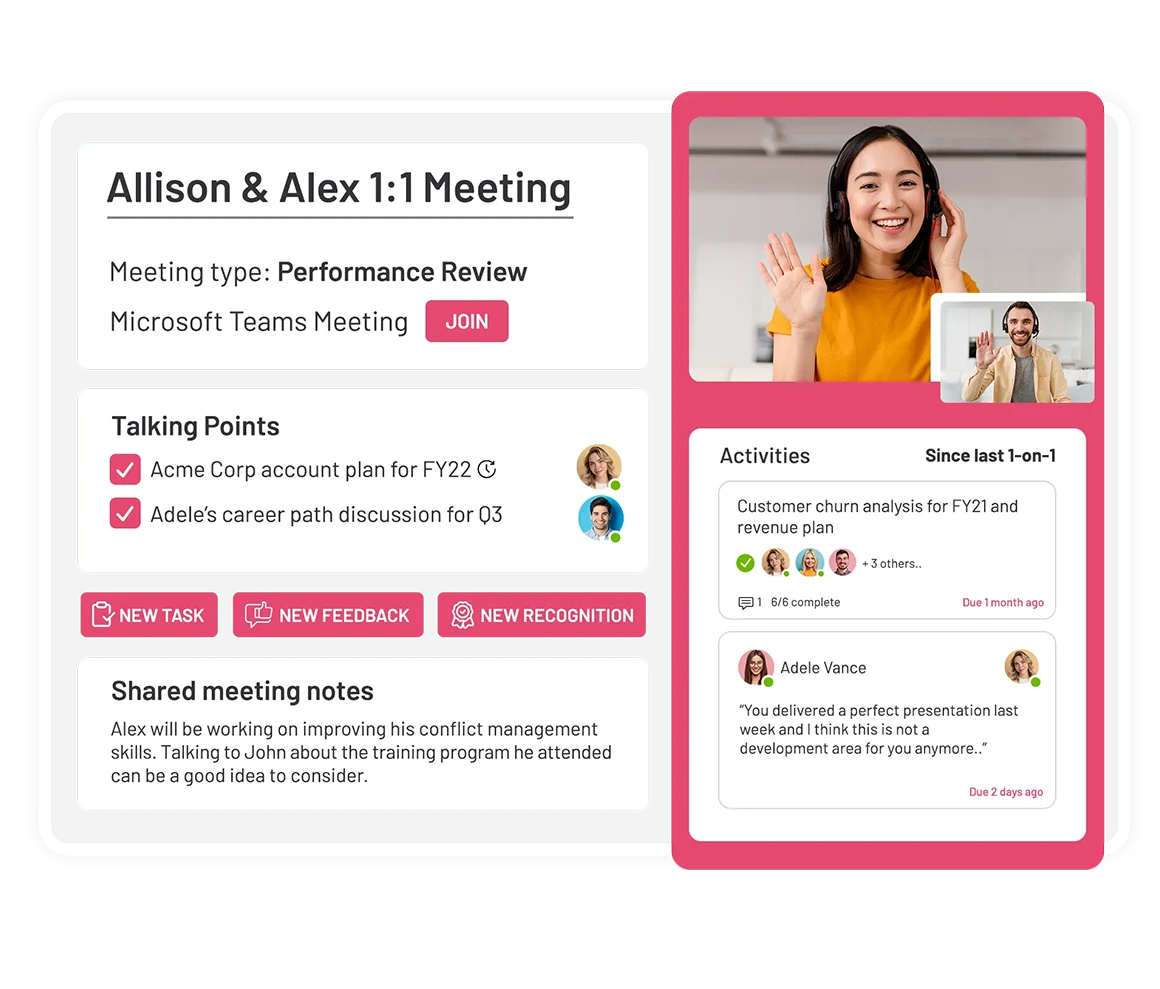Just what exactly is the optimal meeting cadence? That is a question everyone has to be asking themselves every single day. Maybe not with that exact same wording but you get the picture. Our understanding of meetings and how often they should be held has changed heavily, especially after a particular world-changing health event that will remain nameless
– But honestly. Remember 2020? How crazy was that? We can’t believe it’s been three years. Where has all the time gone? –
The point is, we have more meetings than ever before with the rise in popularity of remote and hybrid work models in the past couple of years. The question is: Is having too many meetings counterproductive? The answer, as is the case with most things performance management, is more nuanced and complicated than a simple yes or no.
A change in meeting frequencies isn’t just related to the advent of remote work models. Goal-setting methodologies such as OKRs and Agile focus heavily on regular meetings and daily stand-ups. So today, we discuss meeting frequencies, and different types of meetings, and find the answer to the following question:
- What is the optimal meeting cadence?
We will also be discussing how you can optimize different types of meetings at various frequencies.
Table of Contents
Different types of meeting frequencies

Now that we have all our bases covered when it comes to discussing the cadence of meetings, we can take a look at different types of meeting frequencies. Think of this as getting your arsenal in order. We are checking all the weapons available to us before we start game planing.
Quarterly Meeting Cadence:
What are quarterly meetings? Quarterly meetings provide an opportunity to discuss long-term strategic goals, evaluate performance, assess roadmaps, and, provide performance feedback. These meetings serve as checkpoints to ensure that the organization is on track, address any challenges or concerns, and make informed decisions moving forward. What are some great meetings that can be conducted at a quarterly cadance?
Strategic Planning Session
During strategic planning sessions, you will be diving into the long-term goals of your organization. You’ll assess and fine-tune your strategic objectives, analyze market trends, and identify exciting opportunities for growth and improvement. It’s all about setting the course for success and charting a path toward your organization’s future.
Performance Evaluation and Feedback
Quarterly performance reviews create an opportunity for managers and team members to come together to discuss performance, set goals, and provide constructive feedback.
It’s a chance to celebrate wins, identify areas for growth, and enhance individual and team effectiveness. It is always a great idea to take advantage of performance review software with customizable performance review templates to make the most of these meetings.
Stakeholder meetings
These meetings involve engaging with important stakeholders, such as investors, partners, and clients. Updates on the organization’s progress, projects, and initiatives are shared. Concerns or questions from stakeholders are addressed, and relationships are nurtured to ensure mutual understanding and collaboration.
Product roadmap meetings
During these meetings, product development plans and priorities for the upcoming quarter are reviewed. The focus is on aligning product features, enhancements, or releases with market demands and customer needs. Adjustments to the roadmap may be made based on feedback, market trends, or changes in business objectives.
Monthly Meeting Cadence:
What are monthly meetings? Monthly meetings as can be deducted from their name, are meetings conducted at a monthly cadence.
Our Holmsian powers of deduction aside, meetings at a monthly cadence serve as important checkpoints, providing regular opportunities for communication, collaboration, and alignment. They help teams stay informed, share progress, address challenges, and make collective decisions.
What are some monthly meetings?
Project Status Update
Ready for a progress check? Gather your team for this monthly meeting, where you’ll review ongoing projects, address challenges, and ensure that everyone is on track to meet project timelines and deliverables.
It’s a chance to celebrate milestones, troubleshoot roadblocks, and keep the project engine running smoothly. If you are practicing Microsoft Teams project management, then you should really consider a one on one software with Microsoft Teams integration to make these meetings go as smoothly as possible.
All Hands Meetings
This monthly meeting is a must-have for remote teams! Setting all-hands meetings at a monthly meeting cadence helps deal with the sense of isolation that comes with remote work. If you are practicing remote team management, then all-hands meetings at a monthly cadence are must-haves for you!
Sales review meetings
These meetings assess the sales team’s performance, review sales targets, and discuss strategies to meet monthly goals. Opportunities for improvement, training needs, and market trends are discussed to optimize sales efforts.
Marketing campaign meetings
Marketing campaign meetings are where marketing campaigns and initiatives are planned, reviewed, and optimized. Performance metrics, campaign effectiveness, and audience engagement are evaluated.
Weekly Meeting Cadence:
We are slowly but surely making our way to meetings at higher frequencies. What are weekly meetings? They are regular meetings conducted at a weekly cadence. Weekly meetings are regular and frequent checkpoints for teams to discuss progress, align priorities, address any emerging issues, and facilitate effective collaboration.

They help teams stay connected, maintain momentum, and ensure that everyone is working towards common goals. If you can’t tell already, we are huge fans of weekly check-ins! Here are some examples:
Agile Sprint Planning
As we discussed previously, a high meeting frequency/meeting cadence is a key aspect of Agile goal-setting methodology. Spring planning sessions are weekly meetings for agile development teams to plan and prioritize tasks for the upcoming sprint. Participants discuss the backlog, assign responsibilities, and establish a clear plan for the sprint.
Team Stand-up
These short, daily or weekly meetings provide an opportunity for team members to quickly share updates on their individual tasks, discuss any obstacles they are facing, and ensure alignment on priorities for the day or week.
Problem-solving meetings
Problem-solving meetings focus on identifying and resolving immediate issues or roadblocks hindering progress. Solutions are brainstormed, decisions are made, and action plans are created to overcome challenges.
Team collaboration meetings
These meetings encourage brainstorming, idea sharing, and collaboration among team members. It helps foster innovation, enhance teamwork, and promote a sense of shared ownership and responsibility.
Daily Meeting Cadence:
And here we are! We took the scenic route but we finally got here. To the highest meeting frequency (We refuse to believe in a world where hourly meetings are “a thing”.). So what are daily meetings?
Daily meetings are meetings conducted at a daily cadence. They provide a platform for timely communication, collaboration, and coordination. If you stretch the definition, and you should, impromptu meetings would fit under this category as well. So what are some classic daily meetings?
Daily Scrum
Also known as a daily stand-up or daily huddle, this short and focused meeting is common in agile development teams. Team members gather to discuss progress on tasks, any challenges or roadblocks encountered, and plans for the day. Methodologies that favor an iterative approach often require a higher meeting frequency.
Morning Kickoff
As the name would suggest, they are quick daily meetings are held at the start of the workday to set the tone and priorities for the day ahead.
Team members share their plans, highlight any urgent tasks or deadlines, and ensure that everyone is on the same page. While a meeting isn’t everyone’s idea of a perfect morning, these meetings help establish focus, alignment, and a shared sense of purpose.
Problem-solving meetings
When an urgent issue arises, a quick problem-solving meeting can be held. Team members come together to analyze the problem, brainstorm solutions, and decide on the best course of action. They allow for timely decision-making and effective resolution of issues.
Check-in or catch-up meetings
These informal meetings are meant to check in with team members, touch base on ongoing projects, or address any immediate concerns. They promote open communication, build relationships, and ensure everyone is on track.
Top 5 Tips on Setting the Perfect Meeting Cadence
By now, you must have realized that there is no perfect one on one meeting cadence that fits every single situation. Meeting frequencies depend heavily on the nature of the meeting itself, along with a million other things.
One on one meetings add one more variable to that mix. The nature of the relationship between you and the individual you will be in the meeting with. How to determine the right one on one meeting cadence? Here are some factors to help you determine the perfect one on one meeting cadence:
1. Assess the Relationship
Consider the nature of the relationship between the meeting participants. Are they direct reports, colleagues, or cross-functional team members? The level of collaboration and interaction required may influence the frequency of one-on-one meetings.
Direct reports may benefit from more frequent meetings to provide guidance and support.
2. Determine the meeting purpose
What you aim to accomplish with these particular one on ones should play a part in determining the optimal meeting frequency for this meeting. Are these meetings primarily for feedback, coaching, project updates, or relationship-building? The purpose of the meetings will help you gauge how often you need to meet to accomplish those goals effectively.
3. Consider the participants
What makes one on one meetings so special is the personal nature they have. A great way to determine the perfect one on one meeting cadence is to simply take into account the preferences and needs of the participants.
Some may prefer more frequent meetings for regular check-ins and guidance, while others may find less frequent meetings sufficient. Checking in with your team on this should definitely earn you some points toward that manager of the year trophy.

4. Flexibility is key
One thing you need to accept is that the perfect meeting cadence, whether we are talking one on one meetings or team check-ins, may evolve over time. As circumstances change, such as project priorities or team dynamics, be open to adjusting the meeting frequency accordingly.
5. Bonus Section: Meeting Duration
While conducting meetings at the right frequency is great, you need to make sure your meetings are the right length as well. Now, we can give you our usual “It depends!” answer about this one too, but instead we will give you some clear numbers to map your meeting durations around.
Quarterly Meetings
Quarterly meetings tend to be more substantial in scope and typically range from 1 to 3 hours, allowing sufficient time for strategic discussions, data analysis, goal setting, and decision-making.
Monthly Meetings
Monthly meetings are often focused on specific topics or updates. Depending on the agenda, they usually last between 1 to 2 hours, providing enough time for in-depth discussions, sharing updates, and collaborative problem-solving.
Weekly Meetings
Weekly meetings are designed for regular check-ins and coordination. They are typically shorter in duration, ranging from 30 minutes to 1 hour. Their concise timeframe maintains focus, encourages efficiency, and guarantees that everyone can participate without disrupting their workflow.
Daily Meetings
Daily meetings are intended for brief updates, alignment, and quick problem-solving. They are generally kept short and concise, typically lasting between 10 to 30 minutes. The goal is to address immediate concerns, share relevant information, and set priorities for the day.
Meeting Software

If you have stuck with us this far, then we have a surprise for you. Did you know that Teamflect, the best meeting software for Microsoft Teams has an incredible free plan?!
- Do you want customizable meeting agendas you can edit before, during, and after meetings?
- Do you want to be able to assign, track, and manage goals and tasks inside ongoing meetings?
You can! Teamflect is an all-in-one performance management system designed specifically for Microsoft Teams that will provide you with the best possible meeting experience in the Microsoft Teams ecosystem.

Teamflect users can manage their meetings any way they choose. With Teamflect, you can:
- Automate meeting frequencies.
- Create recurring talking points.
- Integrate goals and tasks into the meeting agenda.
- Take shared and private meeting notes that are synced with OneNote.
- And more!



